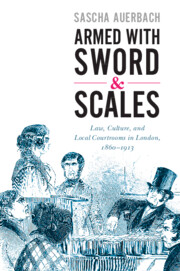Book contents
- Armed with Swords & Scales
- Studies in Legal History
- Armed with Swords & Scales
- Copyright page
- Dedication
- Epigraph
- Contents
- Figures
- Acknowledgments
- Glossary of Terms and Abbreviations
- Introduction
- 1 “Many-Coloured Scenes of Life”
- 2 “A Ruffian Rightly Punished”
- 3 “An Evil Quarter of an Hour about the Precincts”
- 4 “Two Shillings’ Worth of Revenge in the Form of a Summons”
- 5 A Poor Woman’s Court of Justice, 1882–1910
- 6 “The Very Centre of Observation and Information”
- Conclusion
- Bibliography
- Printed Primary Sources
- Secondary Sources
- Index
2 - “A Ruffian Rightly Punished”
Morality and Local Courtrooms in Practice and Portrayal, 1860–80
Published online by Cambridge University Press: 05 February 2021
- Armed with Swords & Scales
- Studies in Legal History
- Armed with Swords & Scales
- Copyright page
- Dedication
- Epigraph
- Contents
- Figures
- Acknowledgments
- Glossary of Terms and Abbreviations
- Introduction
- 1 “Many-Coloured Scenes of Life”
- 2 “A Ruffian Rightly Punished”
- 3 “An Evil Quarter of an Hour about the Precincts”
- 4 “Two Shillings’ Worth of Revenge in the Form of a Summons”
- 5 A Poor Woman’s Court of Justice, 1882–1910
- 6 “The Very Centre of Observation and Information”
- Conclusion
- Bibliography
- Printed Primary Sources
- Secondary Sources
- Index
Summary
The second chapter examines how public portrayals of local courtrooms continued to change in tandem with the widening reach of summary justice in the second half of the nineteenth century. In this period, magistrates’ courtrooms became among the most common and public sites of personal, concrete contact between ordinary citizens and the state in its various guises. As the advertisements that crowded the pages of the new popular press broadcast the expanding availability of products and services, columns of “Police Intelligence” broadcast the expanding roles of courtrooms and the authority of magistrates, police, and municipal agents. In doing so, they served to delineate that authority in the public eye and to either condone or condemn – largely the former – its expression and to assess the morality of individual responses to it. By portraying these daily encounters between the state and the people, police-court columns offered readers a common standard for defining morality, for determining victims and villains, and for measuring justice and injustice in the courtroom.
- Type
- Chapter
- Information
- Armed with Sword and ScalesLaw, Culture, and Local Courtrooms in London, 1860–1913, pp. 109 - 140Publisher: Cambridge University PressPrint publication year: 2021

